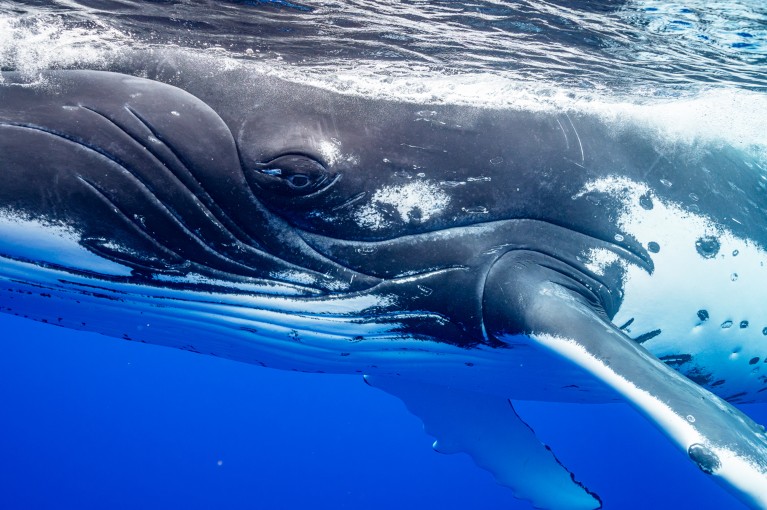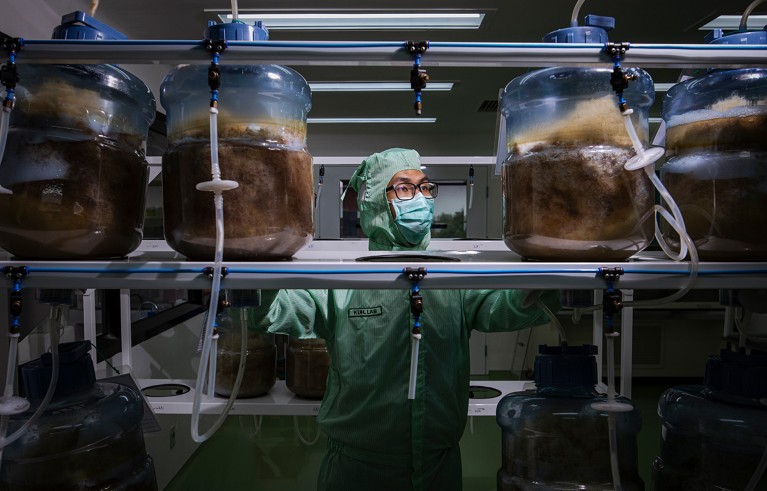You have full access to this article via your institution.
Hello Nature readers, would you like to get this Briefing in your inbox free every day? Sign up here.

The eyesight of the humpack whale is much less sharp than the size of its eyes would suggest. Credit: Shane Gross/Nature Picture Library
Despite having eyes the size of an orange, the humpback whale (Megaptera novaeangliae) has limited visual acuity, similar to nearsightedness. An in-depth analysis of an eye taken from a juvenile that was stranded in North Carolina reveals that the whale was likely capable of making out large objects at a distance, but could only see finer details when objects are closer — within about 30 metres, or two average body lengths. That makes humpbacks vulnerable to becoming entangled in fishing gear, one of their leading causes of death.
Discover | 4 min read or get the gist in 1 minute in the Nature Research Highlight (paywall)
Reference: Proceedings of the Royal Society B paper
A clinical trial of engineered immune cells called chimeric antigen receptor (CAR) T cells is among the first to show that this type of treatment can work for hard-to-treat solid tumours. Compared to those who received standard care, people with gastrointestinal cancer who got the CAR-T-cell therapy — called satricabtagene autoleucel (satri-cel) — were more likely to respond to treatment, lived a couple of months longer and were 31% less likely to die over the study period. The results suggest that CAR-T cells can be further optimized to treat people with solid tumours, says cancer researcher Lisa Mielke, but this treatment did come with a high rate of side effects.
Reference: The Lancet paper
A small genetic change to Yersinia pestis — the bacterium that causes the plague — makes it less fatal, but possibly more transmissible. By comparing modern and ancient samples, researchers found that a gene called pla, which is associated with disease severity, can be depleted towards the end of epidemics. The team hypothesized that this depletion occurred because plague outbreaks shrank the size of the rodent populations the bacteria rely on to spread. A less fatal strain would have allowed infected rodents more time to travel between fragmented populations and spread the disease.
Features & opinion
“Humans are building a future in space. But we are not built for space,” writes physician Farhan Asrar. As missions such as NASA’s Artemis programme aim to take humans to the moon, and later Mars, innovations designed to address the challenges of space travel can also benefit people on Earth, argues Asrar. For example, learning how to grow food on space missions could help improve techniques for growing crops in harsh environments on our planet.
Planetary warming is rapidly closing thewindow for understanding the polar regions and the processes they control, writes evolutionary biologist Neil Shubin in his book, Ends of the Earth. The poles’ extreme conditions make them uniquely valuable for scientific discovery, and their role in driving environmental dynamics should centre them in policy debates around climate change, Shubin writes. The book is “a joy to read”, says physical geographer Marc Macias-Fauria in his review, but its focus on natural sciences can sideline “one of the most essential dimensions of the Arctic: its peoples”.
After two bad experiences, a postdoc asks how to find a trustworthy principal investigator (PI) in the latest advice column from Nature Careers. Two academics and two career coaches say that the first step is to identify what you want. Then interview potential PIs, talk to their other postdocs and get support from a network of colleagues. Finally, check in on yourself once the job has begun. “When you’re two to three months in, ask yourself, ‘Is this what I thought it was? Is it delivering on the things that I needed?’” suggests academic coach Emma Williams. “An annual appraisal is just too long to wait.”
Where I work

Johan Sukweenadhi is a plant scientist at the University of Surabaya, Indonesia.Credit: Ulet Ifansasti for Nature
Plant scientist Johan Sukweenadhi is working to turbocharge the growth of the medicinal plant ginseng (Panax ginseng). “We use a method known as hairy-root culture, which uses the soil bacterium Rhizobium rhizogenes to infect plant roots, causing them to grow abnormally fast in artificial media without producing stems or leaves,” he says. “Although the root itself is a valuable crop, our ultimate goal is to discover medicines.” (Nature | 3 min read)
On Friday, our Leif Penguinson was taking a dip in the cool waters of Lago das Fadas in Tijuca National Park, in Brazil. Did you find the penguin? When you’re ready, here’s the answer.
Thanks for reading,
Flora Graham, senior editor, Nature Briefing
With contributions by Jacob Smith
Want more? Sign up to our other free Nature Briefing newsletters:
• Nature Briefing: Careers — insights, advice and award-winning journalism to help you optimize your working life
• Nature Briefing: Microbiology — the most abundant living entities on our planet — microorganisms — and the role they play in health, the environment and food systems
• Nature Briefing: Anthropocene — climate change, biodiversity, sustainability and geoengineering
• Nature Briefing: AI & Robotics — 100% written by humans, of course
• Nature Briefing: Cancer — a weekly newsletter written with cancer researchers in mind
• Nature Briefing: Translational Research — covers biotechnology, drug discovery and pharma


